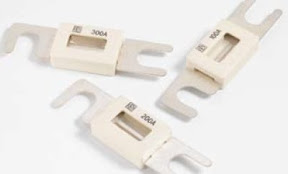Alan B
100 GW
Electric Bicycles have batteries capable of delivering a lot of current in a short time. Good design calls for a fuse or circuit breaker within a few inches of the battery to protect wiring, batteries and in some cases body parts from becoming damaged. Some battery chemistries can "vent to flame" when shorted, so this can be a fairly serious hazard.
It is important that fuses or circuit breakers be properly selected for the application. Both voltage and current are important. Using a protection device with too low a voltage rating can cause the device to fail and not provide the desired safety.
Many common fuses are not up to either the voltage rating or the current rating demanded in electric bicycles. This topic will be a place for folks to discuss this and share the products they have found that are useful for this application.
The fuse should be close to the batteries to provide maximum protection. It doesn't do much good if the protection is downstream of the short. Ideally it should be either in the middle of the battery chain or immediately at one end.
Here is one that I found that I plan to use in my system:

http://www.littelfuse.com/data/en/Data_Sheets/1575701_Strip_fuses.pdf
Rated at 80 volts and various currents from 35 to 500 amps these units are designed for electric vehicles. They cost about $6 each at Mouser. A mounting plate can be fabricated from a piece of plastic and some bolts. Or bolt wires to it and slide inside a piece of PVC or ABS pipe to insulate and mechanically protect it.
My design is still evolving, but at this point I plan to put a fuse right inside the battery box. I will build it into the wiring that the batteries plug into. I'll keep the Turnigy Lipo connectors as-delivered from HK, and then make a series/parallel harness that brings them out to one connector, or perhaps two - one smaller for precharge and the big guy for the main current.
Originally I was planning to use MaxiFuses, and those are okay at lower voltages. Since I have fallen for a higher turn motor and I need to move to higher voltages the Maxi's are no longer suitable for my setup. I have noticed that fuseholders often fail in high current usage, so make sure you select a high quality holder.
Circuit Breakers are another choice. After I started this thread Solar systems became very mainstream and the availability of inexpensive solar circuit breakers with DC ratings increased. I used one on the CroBorg build, and it has worked well, though a 63 amp unit did trip at 80 amps climbing a steep hill. Usually the time at full current is too low, but one day I tripped it. So I moved to a 100 amp unit. At this point I think the breaker is a better choice unless the fuse is rated high enough to only pop on a short overload.
So, what solutions are people using in their bikes?
Links to older threads would also be good to tie the information together:
http://endless-sphere.com/forums/viewtopic.php?f=3&t=22749
It is important that fuses or circuit breakers be properly selected for the application. Both voltage and current are important. Using a protection device with too low a voltage rating can cause the device to fail and not provide the desired safety.
Many common fuses are not up to either the voltage rating or the current rating demanded in electric bicycles. This topic will be a place for folks to discuss this and share the products they have found that are useful for this application.
The fuse should be close to the batteries to provide maximum protection. It doesn't do much good if the protection is downstream of the short. Ideally it should be either in the middle of the battery chain or immediately at one end.
Here is one that I found that I plan to use in my system:

http://www.littelfuse.com/data/en/Data_Sheets/1575701_Strip_fuses.pdf
Rated at 80 volts and various currents from 35 to 500 amps these units are designed for electric vehicles. They cost about $6 each at Mouser. A mounting plate can be fabricated from a piece of plastic and some bolts. Or bolt wires to it and slide inside a piece of PVC or ABS pipe to insulate and mechanically protect it.
My design is still evolving, but at this point I plan to put a fuse right inside the battery box. I will build it into the wiring that the batteries plug into. I'll keep the Turnigy Lipo connectors as-delivered from HK, and then make a series/parallel harness that brings them out to one connector, or perhaps two - one smaller for precharge and the big guy for the main current.
Originally I was planning to use MaxiFuses, and those are okay at lower voltages. Since I have fallen for a higher turn motor and I need to move to higher voltages the Maxi's are no longer suitable for my setup. I have noticed that fuseholders often fail in high current usage, so make sure you select a high quality holder.
Circuit Breakers are another choice. After I started this thread Solar systems became very mainstream and the availability of inexpensive solar circuit breakers with DC ratings increased. I used one on the CroBorg build, and it has worked well, though a 63 amp unit did trip at 80 amps climbing a steep hill. Usually the time at full current is too low, but one day I tripped it. So I moved to a 100 amp unit. At this point I think the breaker is a better choice unless the fuse is rated high enough to only pop on a short overload.
So, what solutions are people using in their bikes?
Links to older threads would also be good to tie the information together:
http://endless-sphere.com/forums/viewtopic.php?f=3&t=22749

